Size effect of r-TiO₂ (micro - and nano) particles on the mechanical property, weathering durability of water-based acrylic coating
This work aims to clarify the difference between the influence of TiO2 particles at micrometer and nanometer sizes on the mechanical properties and weathering durability of waterbased acrylic coatings. To prepare coatings, micro-R-TiO2 and nano R-TiO2 particles with 2 wt.%
content were dispersed in the emulsion acrylic polymer by ultrasonic vibration. The coatings
without TiO2 particles, with 2 wt.% micro R-TiO2 and with 2 wt.% nano R-TiO2 were tested for
abrasion resistance, weathering aging in UV/CON accelerated weathering chamber. Weathering aging was assessed by IR quantitative analysis, the weight loss of the coating. The obtained
results showed that the micro R-TiO2 with the 2 wt.% content enhanced simultaneously the abrasion resistance and weathering durability of water-based acrylic coatings but not as effectively as
nano R-TiO2. Incorporation of 2 wt.% micro-R-TiO2 increased slightly the abrasion resistance
of coating from 78.4 to 98.9 lite/mil (26% increase) while with addition of nano-R-TiO2 at the
same content, the abrasion resistance was significantly improved from 78.4 to 129.3 lite/mil (65%
increase). After 48 aging cycles, the alkane CH groups and weight of the coatings without RTiO2 particles, containing 2 wt.% micro-R-TiO2, containing nano-R-TiO2 lost 34.2% and 17.4%;
23.8% and 13%; 13.7% and 13 %, respectively.
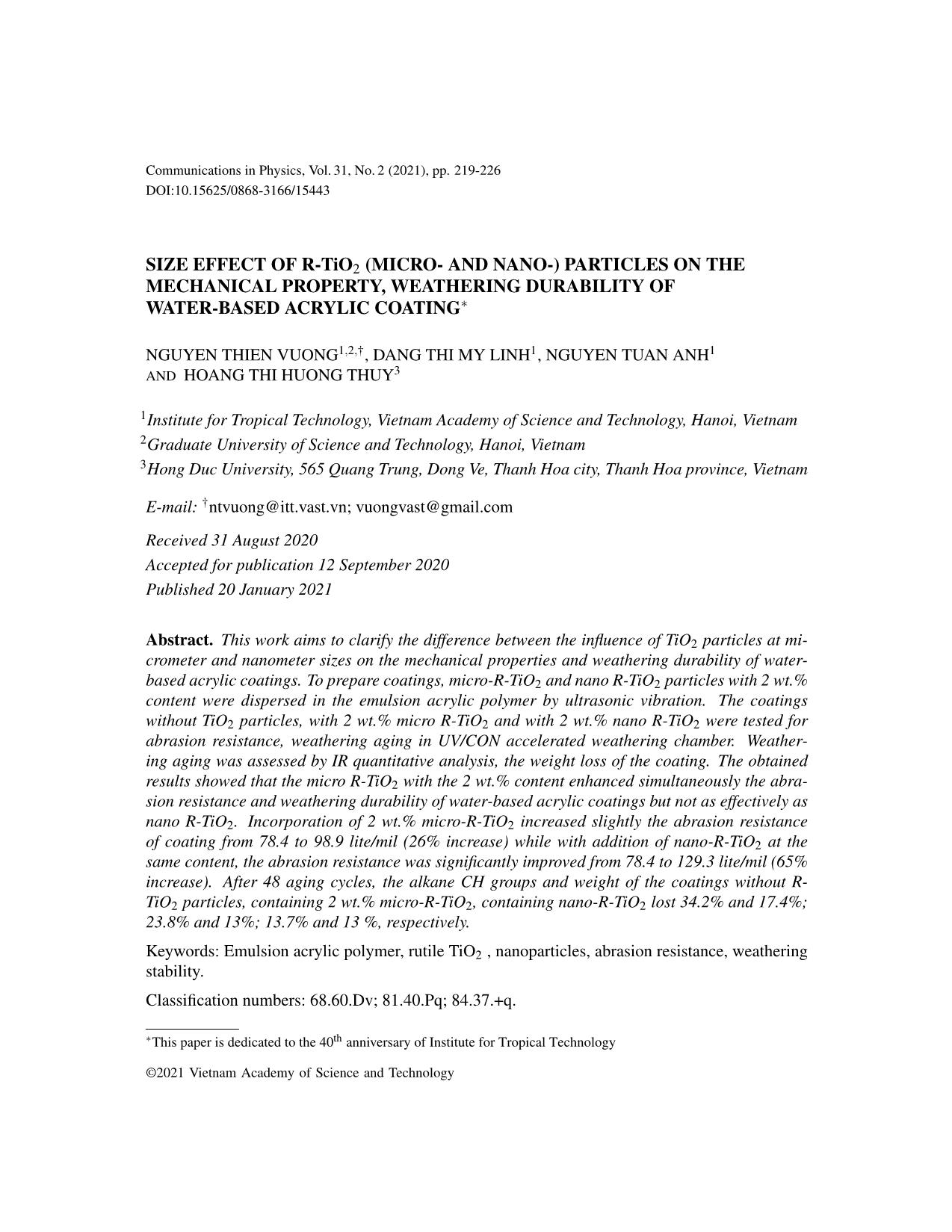
Trang 1
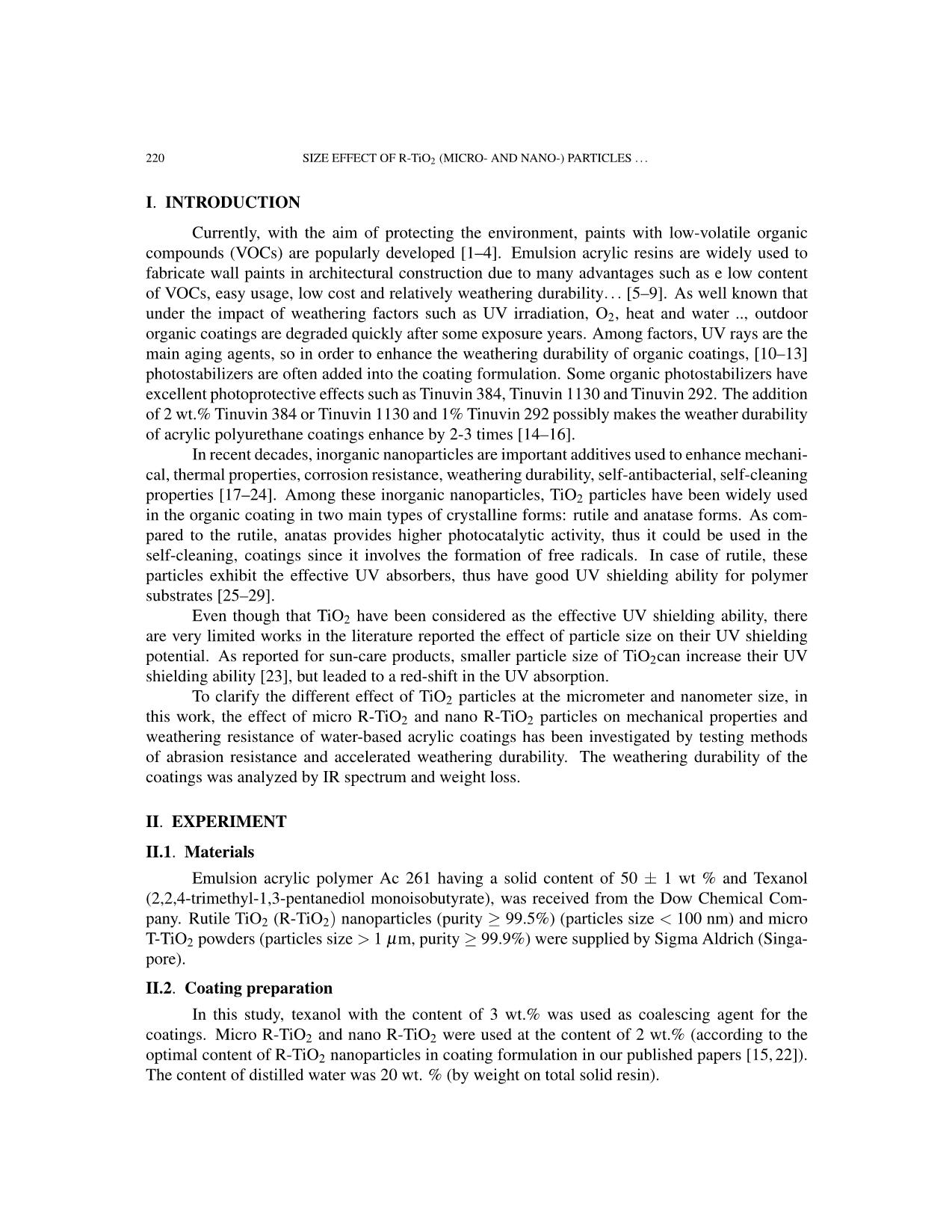
Trang 2
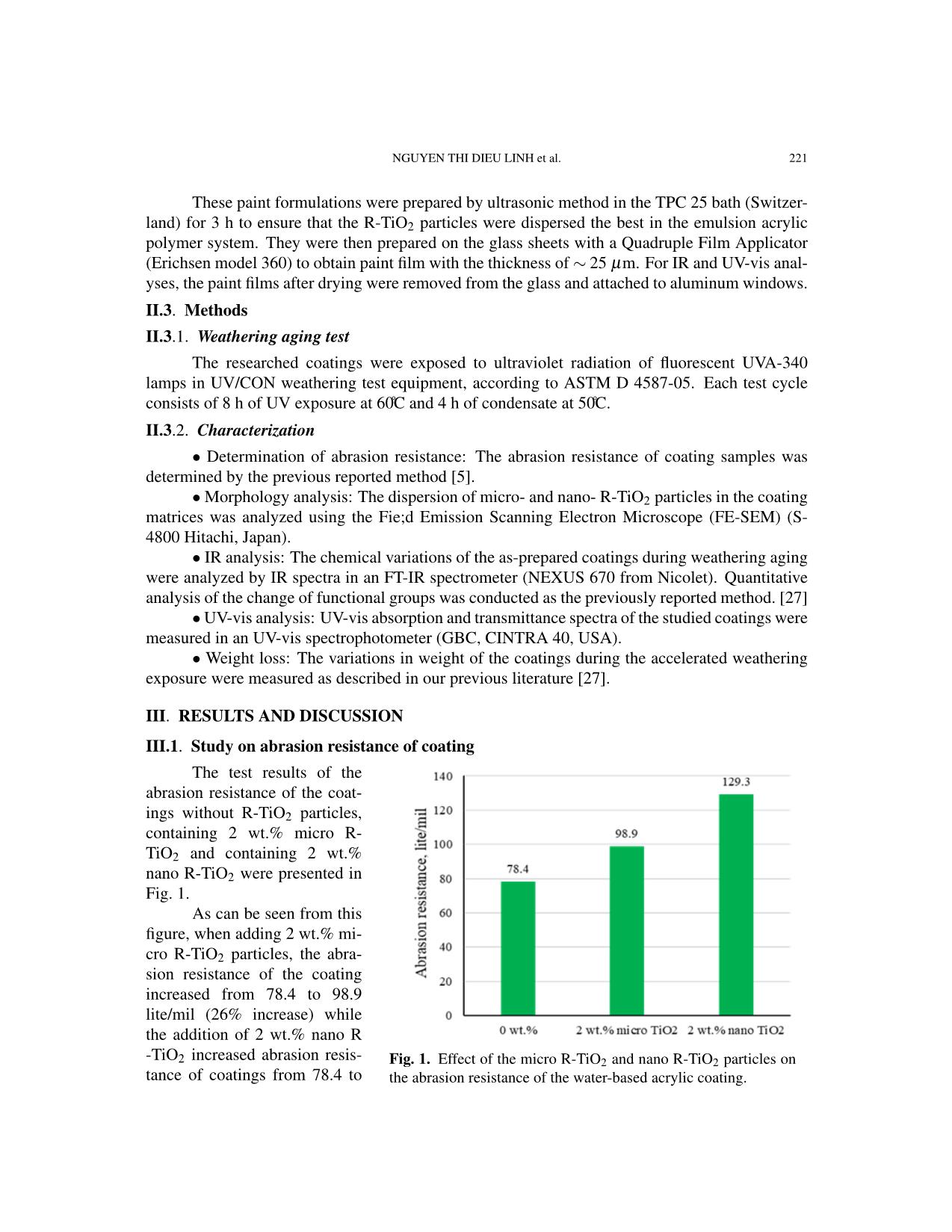
Trang 3
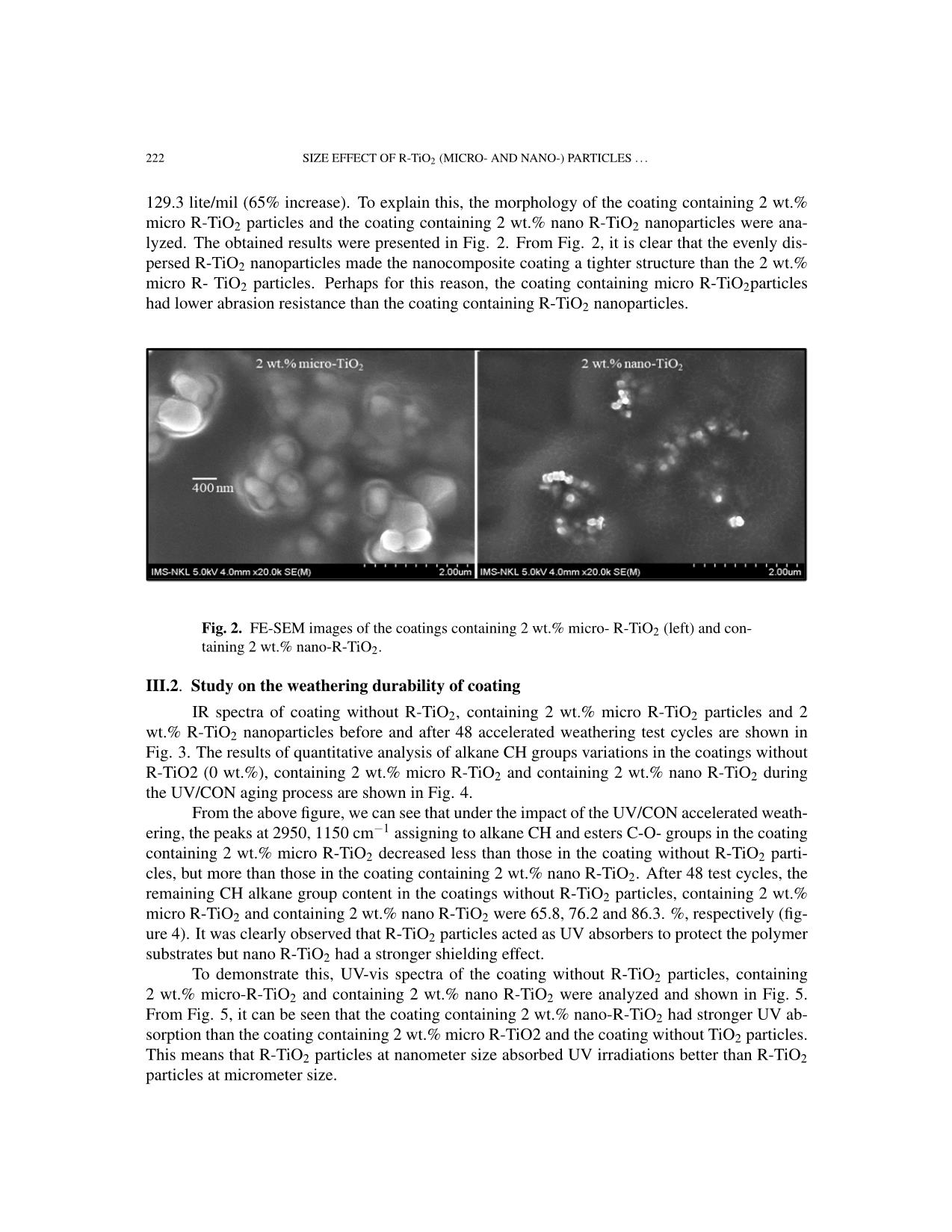
Trang 4
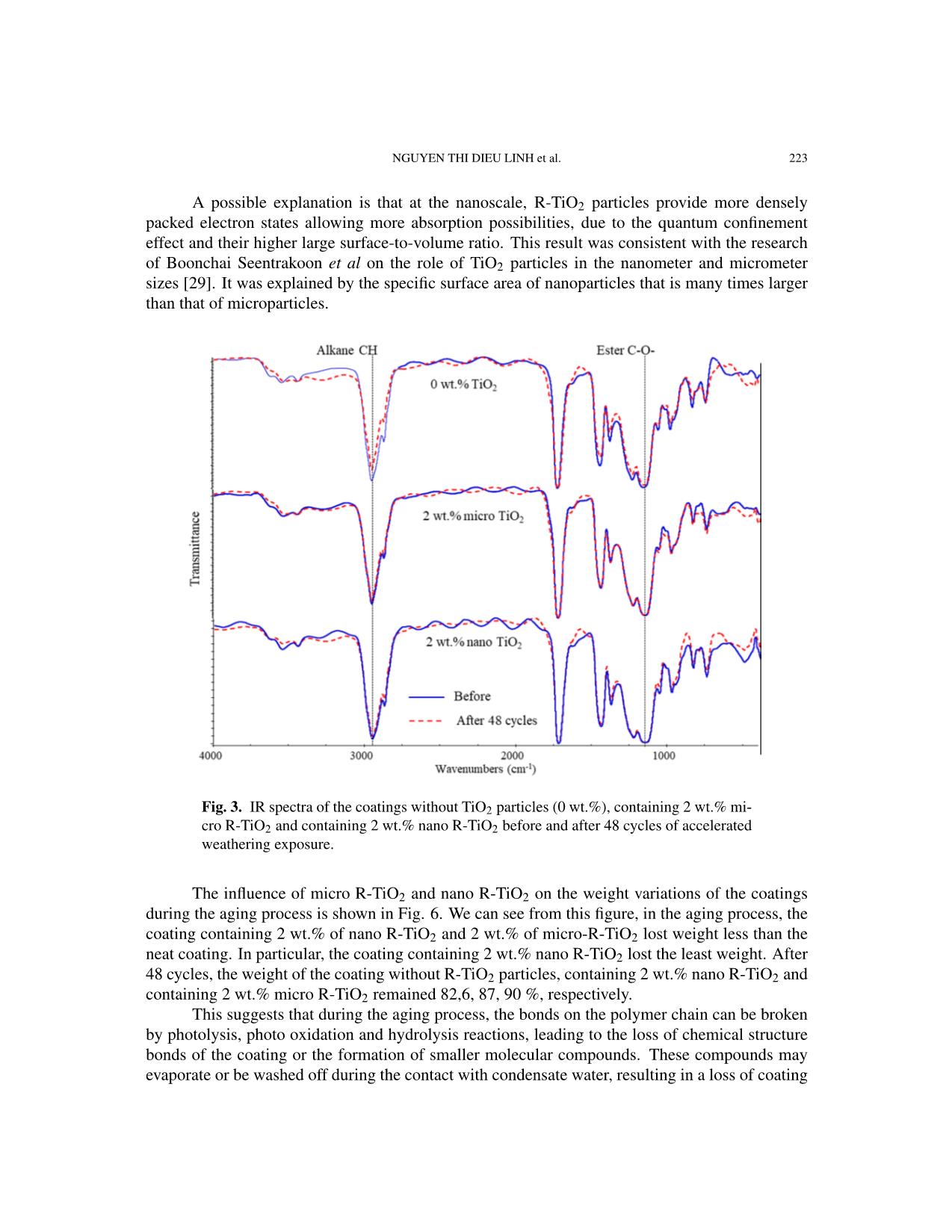
Trang 5
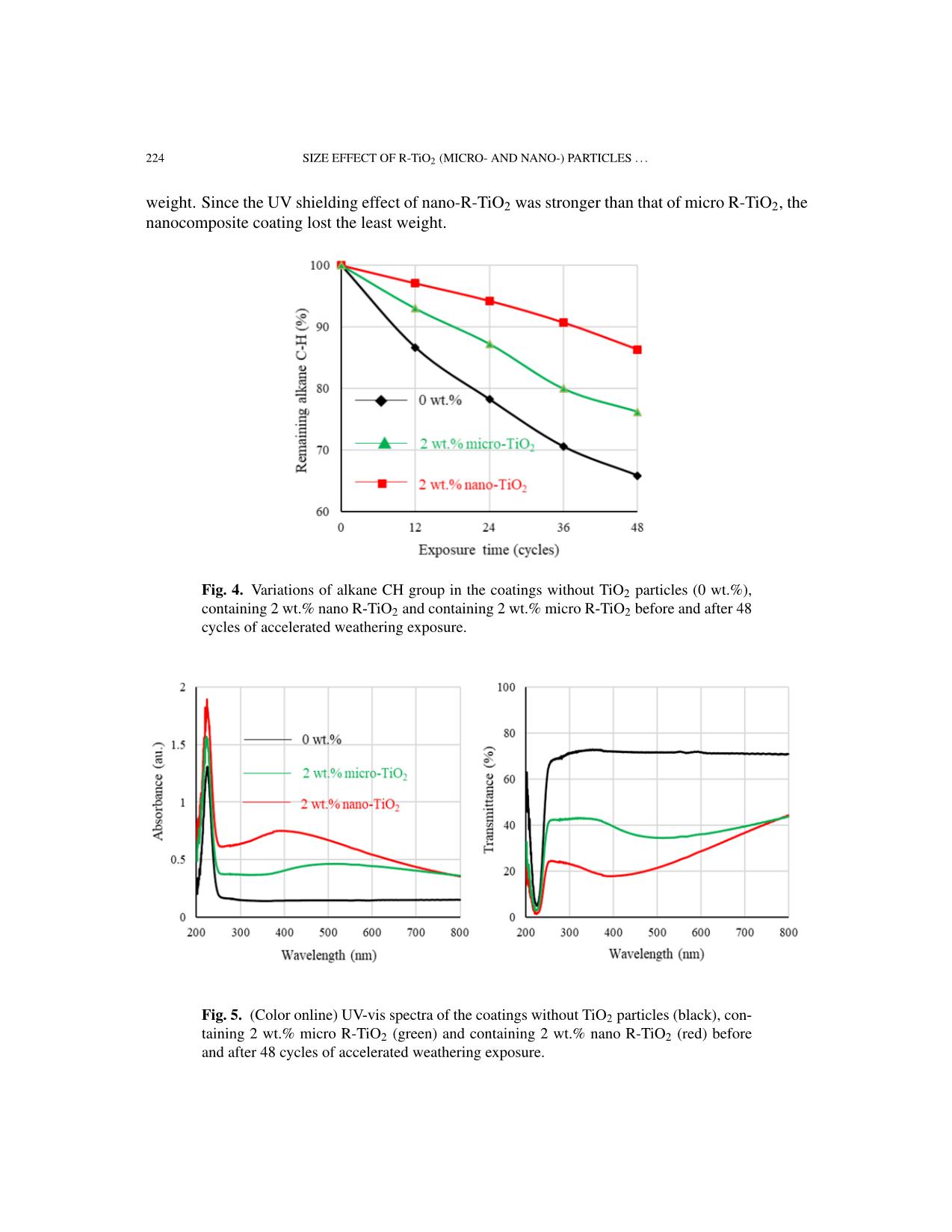
Trang 6
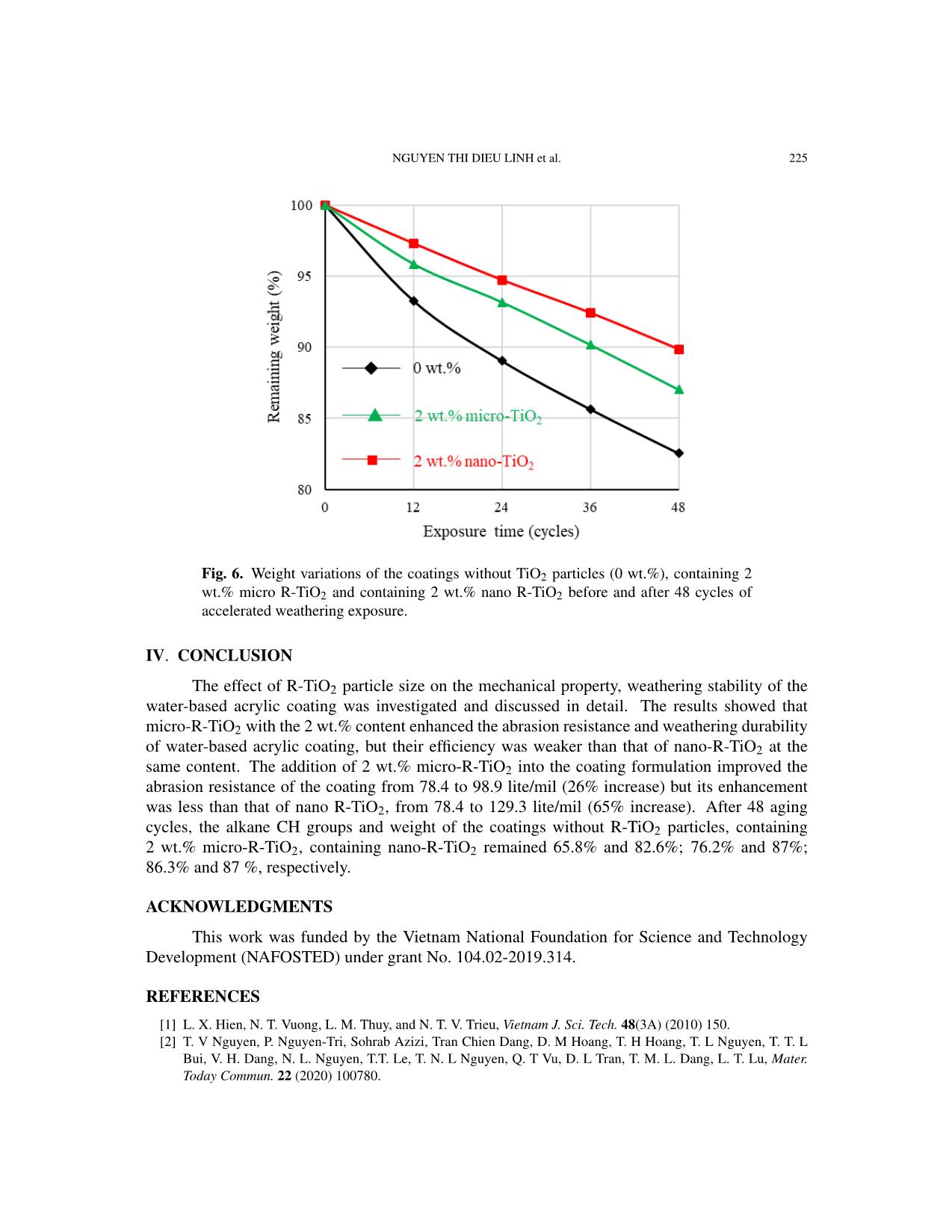
Trang 7
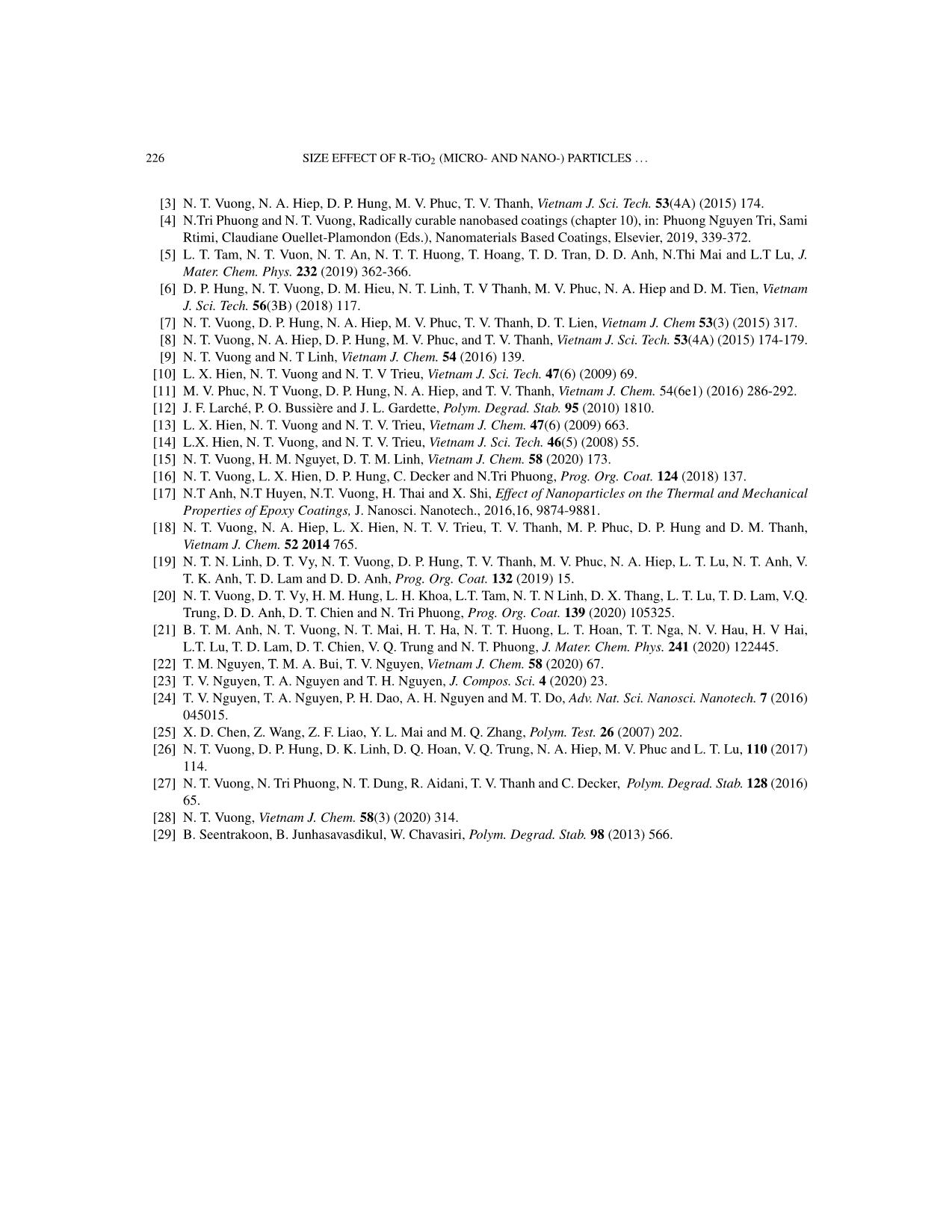
Trang 8
Tóm tắt nội dung tài liệu: Size effect of r-TiO₂ (micro - and nano) particles on the mechanical property, weathering durability of water-based acrylic coating
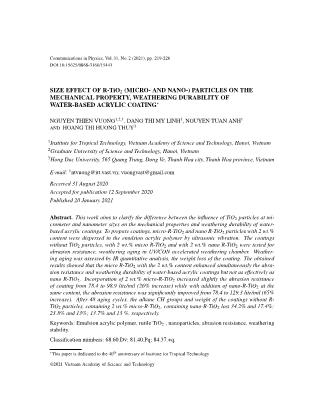
Communications in Physics, Vol.31, No. 2 (2021), pp. 219-226 DOI:10.15625/0868-3166/15443 SIZE EFFECT OF R-TiO2 (MICRO- AND NANO-) PARTICLES ON THE MECHANICAL PROPERTY, WEATHERING DURABILITY OF WATER-BASED ACRYLIC COATING∗ NGUYEN THIEN VUONG1,2,†, DANG THI MY LINH1, NGUYEN TUAN ANH1 AND HOANG THI HUONG THUY3 1Institute for Tropical Technology, Vietnam Academy of Science and Technology, Hanoi, Vietnam 2Graduate University of Science and Technology, Hanoi, Vietnam 3Hong Duc University, 565 Quang Trung, Dong Ve, Thanh Hoa city, Thanh Hoa province, Vietnam E-mail: †ntvuong@itt.vast.vn; vuongvast@gmail.com Received 31 August 2020 Accepted for publication 12 September 2020 Published 20 January 2021 Abstract. This work aims to clarify the difference between the influence of TiO2 particles at mi- crometer and nanometer sizes on the mechanical properties and weathering durability of water- based acrylic coatings. To prepare coatings, micro-R-TiO2 and nano R-TiO2 particles with 2 wt.% content were dispersed in the emulsion acrylic polymer by ultrasonic vibration. The coatings without TiO2 particles, with 2 wt.% micro R-TiO2 and with 2 wt.% nano R-TiO2 were tested for abrasion resistance, weathering aging in UV/CON accelerated weathering chamber. Weather- ing aging was assessed by IR quantitative analysis, the weight loss of the coating. The obtained results showed that the micro R-TiO2 with the 2 wt.% content enhanced simultaneously the abra- sion resistance and weathering durability of water-based acrylic coatings but not as effectively as nano R-TiO2. Incorporation of 2 wt.% micro-R-TiO2 increased slightly the abrasion resistance of coating from 78.4 to 98.9 lite/mil (26% increase) while with addition of nano-R-TiO2 at the same content, the abrasion resistance was significantly improved from 78.4 to 129.3 lite/mil (65% increase). After 48 aging cycles, the alkane CH groups and weight of the coatings without R- TiO2 particles, containing 2 wt.% micro-R-TiO2, containing nano-R-TiO2 lost 34.2% and 17.4%; 23.8% and 13%; 13.7% and 13 %, respectively. Keywords: Emulsion acrylic polymer, rutile TiO2 , nanoparticles, abrasion resistance, weathering stability. Classification numbers: 68.60.Dv; 81.40.Pq; 84.37.+q. ∗This paper is dedicated to the 40th anniversary of Institute for Tropical Technology ©2021 Vietnam Academy of Science and Technology 220 SIZE EFFECT OF R-TiO2 (MICRO- AND NANO-) PARTICLES ... I. INTRODUCTION Currently, with the aim of protecting the environment, paints with low-volatile organic compounds (VOCs) are popularly developed [1–4]. Emulsion acrylic resins are widely used to fabricate wall paints in architectural construction due to many advantages such as e low content of VOCs, easy usage, low cost and relatively weathering durability... [5–9]. As well known that under the impact of weathering factors such as UV irradiation, O2, heat and water .., outdoor organic coatings are degraded quickly after some exposure years. Among factors, UV rays are the main aging agents, so in order to enhance the weathering durability of organic coatings, [10–13] photostabilizers are often added into the coating formulation. Some organic photostabilizers have excellent photoprotective effects such as Tinuvin 384, Tinuvin 1130 and Tinuvin 292. The addition of 2 wt.% Tinuvin 384 or Tinuvin 1130 and 1% Tinuvin 292 possibly makes the weather durability of acrylic polyurethane coatings enhance by 2-3 times [14–16]. In recent decades, inorganic nanoparticles are important additives used to enhance mechani- cal, thermal properties, corrosion resistance, weathering durability, self-antibacterial, self-cleaning properties [17–24]. Among these inorganic nanoparticles, TiO2 particles have been widely used in the organic coating in two main types of crystalline forms: rutile and anatase forms. As com- pared to the rutile, anatas provides higher photocatalytic activity, thus it could be used in the self-cleaning, coatings since it involves the formation of free radicals. In case of rutile, these particles exhibit the effective UV absorbers, thus have good UV shielding ability for polymer substrates [25–29]. Even though that TiO2 have been considered as the effective UV shielding ability, there are very limited works in the literature reported the effect of particle size on their UV shielding potential. As reported for sun-care products, smaller particle size of TiO2can increase their UV shielding ability [23], but leaded to a red-shift in the UV absorption. To clarify the different effect of TiO2 particles at the micrometer and nanometer size, in this work, the effect of micro R-TiO2 and nano R-TiO2 particles on mechanical properties and weathering resistance of water-based acrylic coatings has been investigated by testing methods of abrasion resistance and accelerated weathering durability. The weathering durability of the coatings was analyzed by IR spectrum and weight loss. II. EXPERIMENT II.1. Materials Emulsion acrylic polymer Ac 261 having a solid content of 50 ± 1 wt % and Texanol (2,2,4-trimethyl-1,3-pentanediol monoisobutyrate), was received from the Dow Chemical Com- pany. Rutile TiO2 (R-TiO2) nanoparticles (purity ≥ 99.5%) (particles size < 100 nm) and micro T-TiO2 powders (particles size > 1 µm, purity ≥ 99.9%) were supplied by Sigma Aldrich (Singa- pore). II.2. Coating preparation In this study, texanol with the content of 3 wt.% was used as coalescing agent for the coatings. Micro R-TiO2 and nano R-TiO2 were used at the content of 2 wt.% (according to the optimal content of R-TiO2 nanoparticles in coating formulation in our published papers [15, 22]). The content of distilled water was 20 wt. % (by weight on total solid resin). NGUYEN THI DIEU LINH et al. 221 These paint formulations were prepared by ultrasonic method in the TPC 25 bath (Switzer- land) for 3 h to ensure that the R-TiO2 particles were dispersed the best in the emulsion acrylic polymer system. They were then prepared on the glass sheets with a Quadruple Film Applicator (Erichsen model 360) to obtain paint film with the thickness of ∼ 25 µm. For IR and UV-vis anal- yses, the paint films after drying were removed from the glass and attached to aluminum windows. II.3. Methods II.3.1. Weathering aging test The researched coatings were exposed to ultraviolet radiation of fluorescent UVA-340 lamps in UV/CON weathering test equipment, according to ASTM D 4587-05. Each test cycle consists of 8 h of UV exposure at 60˚C and 4 h of condensate at 50˚C. II.3.2. Characterization • Determination of abrasion resistance: The abrasion resistance of coating samples was determined by the previous reported method [5]. • Morphology analysis: The dispersion of micro- and nano- R-TiO2 particles in the coating matrices was analyzed using the Fie;d Emission Scanning Electron Microscope (FE-SEM) (S- 4800 Hitachi, Japan). • IR analysis: The chemical variations of the as-prepared coatings during weathering aging were analyzed by IR spectra in an FT-IR spectrometer (NEXUS 670 from Nicolet). Quantitative analysis of the change of functional groups was conducted as the previously reported method. [27] • UV-vis analysis: UV-vis absorption and transmittance spectra of the studied coatings were measured in an UV-vis spectrophotometer (GBC, CINTRA 40, USA). • Weight loss: The variations in weight of the coatings during the accelerated weathering exposure were measured as described in our previous literature [27]. III. RESULTS AND DISCUSSION III.1. Study on abrasion resistance of coating The test results of the abrasion resistance of the coat- ings without R-TiO2 particles, containing 2 wt.% micro R- TiO2 and containing 2 wt.% nano R-TiO2 were presented in Fig. 1. As can be seen from this figure, when adding 2 wt.% mi- cro R-TiO2 particles, the abra- sion resistance of the coating increased from 78.4 to 98.9 lite/mil (26% increase) while the addition of 2 wt.% nano R -TiO2 increased abrasion resis- Fig. 1. Effect of the micro R-TiO2 and nano R-TiO2 particles on tance of coatings from 78.4 to the abrasion resistance of the water-based acrylic coating. 222 SIZE EFFECT OF R-TiO2 (MICRO- AND NANO-) PARTICLES ... 129.3 lite/mil (65% increase). To explain this, the morphology of the coating containing 2 wt.% micro R-TiO2 particles and the coating containing 2 wt.% nano R-TiO2 nanoparticles were ana- lyzed. The obtained results were presented in Fig. 2. From Fig. 2, it is clear that the evenly dis- persed R-TiO2 nanoparticles made the nanocomposite coating a tighter structure than the 2 wt.% micro R- TiO2 particles. Perhaps for this reason, the coating containing micro R-TiO2particles had lower abrasion resistance than the coating containing R-TiO2 nanoparticles. Fig. 2. FE-SEM images of the coatings containing 2 wt.% micro- R-TiO2 (left) and con- taining 2 wt.% nano-R-TiO2. III.2. Study on the weathering durability of coating IR spectra of coating without R-TiO2, containing 2 wt.% micro R-TiO2 particles and 2 wt.% R-TiO2 nanoparticles before and after 48 accelerated weathering test cycles are shown in Fig. 3. The results of quantitative analysis of alkane CH groups variations in the coatings without R-TiO2 (0 wt.%), containing 2 wt.% micro R-TiO2 and containing 2 wt.% nano R-TiO2 during the UV/CON aging process are shown in Fig. 4. From the above figure, we can see that under the impact of the UV/CON accelerated weath- ering, the peaks at 2950, 1150 cm−1 assigning to alkane CH and esters C-O- groups in the coating containing 2 wt.% micro R-TiO2 decreased less than those in the coating without R-TiO2 parti- cles, but more than those in the coating containing 2 wt.% nano R-TiO2. After 48 test cycles, the remaining CH alkane group content in the coatings without R-TiO2 particles, containing 2 wt.% micro R-TiO2 and containing 2 wt.% nano R-TiO2 were 65.8, 76.2 and 86.3. %, respectively (fig- ure 4). It was clearly observed that R-TiO2 particles acted as UV absorbers to protect the polymer substrates but nano R-TiO2 had a stronger shielding effect. To demonstrate this, UV-vis spectra of the coating without R-TiO2 particles, containing 2 wt.% micro-R-TiO2 and containing 2 wt.% nano R-TiO2 were analyzed and shown in Fig. 5. From Fig. 5, it can be seen that the coating containing 2 wt.% nano-R-TiO2 had stronger UV ab- sorption than the coating containing 2 wt.% micro R-TiO2 and the coating without TiO2 particles. This means that R-TiO2 particles at nanometer size absorbed UV irradiations better than R-TiO2 particles at micrometer size. NGUYEN THI DIEU LINH et al. 223 A possible explanation is that at the nanoscale, R-TiO2 particles provide more densely packed electron states allowing more absorption possibilities, due to the quantum confinement effect and their higher large surface-to-volume ratio. This result was consistent with the research of Boonchai Seentrakoon et al on the role of TiO2 particles in the nanometer and micrometer sizes [29]. It was explained by the specific surface area of nanoparticles that is many times larger than that of microparticles. Fig. 3. IR spectra of the coatings without TiO2 particles (0 wt.%), containing 2 wt.% mi- cro R-TiO2 and containing 2 wt.% nano R-TiO2 before and after 48 cycles of accelerated weathering exposure. The influence of micro R-TiO2 and nano R-TiO2 on the weight variations of the coatings during the aging process is shown in Fig. 6. We can see from this figure, in the aging process, the coating containing 2 wt.% of nano R-TiO2 and 2 wt.% of micro-R-TiO2 lost weight less than the neat coating. In particular, the coating containing 2 wt.% nano R-TiO2 lost the least weight. After 48 cycles, the weight of the coating without R-TiO2 particles, containing 2 wt.% nano R-TiO2 and containing 2 wt.% micro R-TiO2 remained 82,6, 87, 90 %, respectively. This suggests that during the aging process, the bonds on the polymer chain can be broken by photolysis, photo oxidation and hydrolysis reactions, leading to the loss of chemical structure bonds of the coating or the formation of smaller molecular compounds. These compounds may evaporate or be washed off during the contact with condensate water, resulting in a loss of coating 224 SIZE EFFECT OF R-TiO2 (MICRO- AND NANO-) PARTICLES ... weight. Since the UV shielding effect of nano-R-TiO2 was stronger than that of micro R-TiO2, the nanocomposite coating lost the least weight. Fig. 4. Variations of alkane CH group in the coatings without TiO2 particles (0 wt.%), containing 2 wt.% nano R-TiO2 and containing 2 wt.% micro R-TiO2 before and after 48 cycles of accelerated weathering exposure. Fig. 5. (Color online) UV-vis spectra of the coatings without TiO2 particles (black), con- taining 2 wt.% micro R-TiO2 (green) and containing 2 wt.% nano R-TiO2 (red) before and after 48 cycles of accelerated weathering exposure. NGUYEN THI DIEU LINH et al. 225 Fig. 6. Weight variations of the coatings without TiO2 particles (0 wt.%), containing 2 wt.% micro R-TiO2 and containing 2 wt.% nano R-TiO2 before and after 48 cycles of accelerated weathering exposure. IV. CONCLUSION The effect of R-TiO2 particle size on the mechanical property, weathering stability of the water-based acrylic coating was investigated and discussed in detail. The results showed that micro-R-TiO2 with the 2 wt.% content enhanced the abrasion resistance and weathering durability of water-based acrylic coating, but their efficiency was weaker than that of nano-R-TiO2 at the same content. The addition of 2 wt.% micro-R-TiO2 into the coating formulation improved the abrasion resistance of the coating from 78.4 to 98.9 lite/mil (26% increase) but its enhancement was less than that of nano R-TiO2, from 78.4 to 129.3 lite/mil (65% increase). After 48 aging cycles, the alkane CH groups and weight of the coatings without R-TiO2 particles, containing 2 wt.% micro-R-TiO2, containing nano-R-TiO2 remained 65.8% and 82.6%; 76.2% and 87%; 86.3% and 87 %, respectively. ACKNOWLEDGMENTS This work was funded by the Vietnam National Foundation for Science and Technology Development (NAFOSTED) under grant No. 104.02-2019.314. REFERENCES [1] L. X. Hien, N. T. Vuong, L. M. Thuy, and N. T. V. Trieu, Vietnam J. Sci. Tech. 48(3A) (2010) 150. [2] T. V Nguyen, P. Nguyen-Tri, Sohrab Azizi, Tran Chien Dang, D. M Hoang, T. H Hoang, T. L Nguyen, T. T. L Bui, V. H. Dang, N. L. Nguyen, T.T. Le, T. N. L Nguyen, Q. T Vu, D. L Tran, T. M. L. Dang, L. T. Lu, Mater. Today Commun. 22 (2020) 100780. 226 SIZE EFFECT OF R-TiO2 (MICRO- AND NANO-) PARTICLES ... [3] N. T. Vuong, N. A. Hiep, D. P. Hung, M. V. Phuc, T. V. Thanh, Vietnam J. Sci. Tech. 53(4A) (2015) 174. [4] N.Tri Phuong and N. T. Vuong, Radically curable nanobased coatings (chapter 10), in: Phuong Nguyen Tri, Sami Rtimi, Claudiane Ouellet-Plamondon (Eds.), Nanomaterials Based Coatings, Elsevier, 2019, 339-372. [5] L. T. Tam, N. T. Vuon, N. T. An, N. T. T. Huong, T. Hoang, T. D. Tran, D. D. Anh, N.Thi Mai and L.T Lu, J. Mater. Chem. Phys. 232 (2019) 362-366. [6] D. P. Hung, N. T. Vuong, D. M. Hieu, N. T. Linh, T. V Thanh, M. V. Phuc, N. A. Hiep and D. M. Tien, Vietnam J. Sci. Tech. 56(3B) (2018) 117. [7] N. T. Vuong, D. P. Hung, N. A. Hiep, M. V. Phuc, T. V. Thanh, D. T. Lien, Vietnam J. Chem 53(3) (2015) 317. [8] N. T. Vuong, N. A. Hiep, D. P. Hung, M. V. Phuc, and T. V. Thanh, Vietnam J. Sci. Tech. 53(4A) (2015) 174-179. [9] N. T. Vuong and N. T Linh, Vietnam J. Chem. 54 (2016) 139. [10] L. X. Hien, N. T. Vuong and N. T. V Trieu, Vietnam J. Sci. Tech. 47(6) (2009) 69. [11] M. V. Phuc, N. T Vuong, D. P. Hung, N. A. Hiep, and T. V. Thanh, Vietnam J. Chem. 54(6e1) (2016) 286-292. [12] J. F. Larché, P. O. Bussière and J. L. Gardette, Polym. Degrad. Stab. 95 (2010) 1810. [13] L. X. Hien, N. T. Vuong and N. T. V. Trieu, Vietnam J. Chem. 47(6) (2009) 663. [14] L.X. Hien, N. T. Vuong, and N. T. V. Trieu, Vietnam J. Sci. Tech. 46(5) (2008) 55. [15] N. T. Vuong, H. M. Nguyet, D. T. M. Linh, Vietnam J. Chem. 58 (2020) 173. [16] N. T. Vuong, L. X. Hien, D. P. Hung, C. Decker and N.Tri Phuong, Prog. Org. Coat. 124 (2018) 137. [17] N.T Anh, N.T Huyen, N.T. Vuong, H. Thai and X. Shi, Effect of Nanoparticles on the Thermal and Mechanical Properties of Epoxy Coatings, J. Nanosci. Nanotech., 2016,16, 9874-9881. [18] N. T. Vuong, N. A. Hiep, L. X. Hien, N. T. V. Trieu, T. V. Thanh, M. P. Phuc, D. P. Hung and D. M. Thanh, Vietnam J. Chem. 52 2014 765. [19] N. T. N. Linh, D. T. Vy, N. T. Vuong, D. P. Hung, T. V. Thanh, M. V. Phuc, N. A. Hiep, L. T. Lu, N. T. Anh, V. T. K. Anh, T. D. Lam and D. D. Anh, Prog. Org. Coat. 132 (2019) 15. [20] N. T. Vuong, D. T. Vy, H. M. Hung, L. H. Khoa, L.T. Tam, N. T. N Linh, D. X. Thang, L. T. Lu, T. D. Lam, V.Q. Trung, D. D. Anh, D. T. Chien and N. Tri Phuong, Prog. Org. Coat. 139 (2020) 105325. [21] B. T. M. Anh, N. T. Vuong, N. T. Mai, H. T. Ha, N. T. T. Huong, L. T. Hoan, T. T. Nga, N. V. Hau, H. V Hai, L.T. Lu, T. D. Lam, D. T. Chien, V. Q. Trung and N. T. Phuong, J. Mater. Chem. Phys. 241 (2020) 122445. [22] T. M. Nguyen, T. M. A. Bui, T. V. Nguyen, Vietnam J. Chem. 58 (2020) 67. [23] T. V. Nguyen, T. A. Nguyen and T. H. Nguyen, J. Compos. Sci. 4 (2020) 23. [24] T. V. Nguyen, T. A. Nguyen, P. H. Dao, A. H. Nguyen and M. T. Do, Adv. Nat. Sci. Nanosci. Nanotech. 7 (2016) 045015. [25] X. D. Chen, Z. Wang, Z. F. Liao, Y. L. Mai and M. Q. Zhang, Polym. Test. 26 (2007) 202. [26] N. T. Vuong, D. P. Hung, D. K. Linh, D. Q. Hoan, V. Q. Trung, N. A. Hiep, M. V. Phuc and L. T. Lu, 110 (2017) 114. [27] N. T. Vuong, N. Tri Phuong, N. T. Dung, R. Aidani, T. V. Thanh and C. Decker, Polym. Degrad. Stab. 128 (2016) 65. [28] N. T. Vuong, Vietnam J. Chem. 58(3) (2020) 314. [29] B. Seentrakoon, B. Junhasavasdikul, W. Chavasiri, Polym. Degrad. Stab. 98 (2013) 566.
File đính kèm:
 size_effect_of_r_tio_micro_and_nano_particles_on_the_mechani.pdf
size_effect_of_r_tio_micro_and_nano_particles_on_the_mechani.pdf

